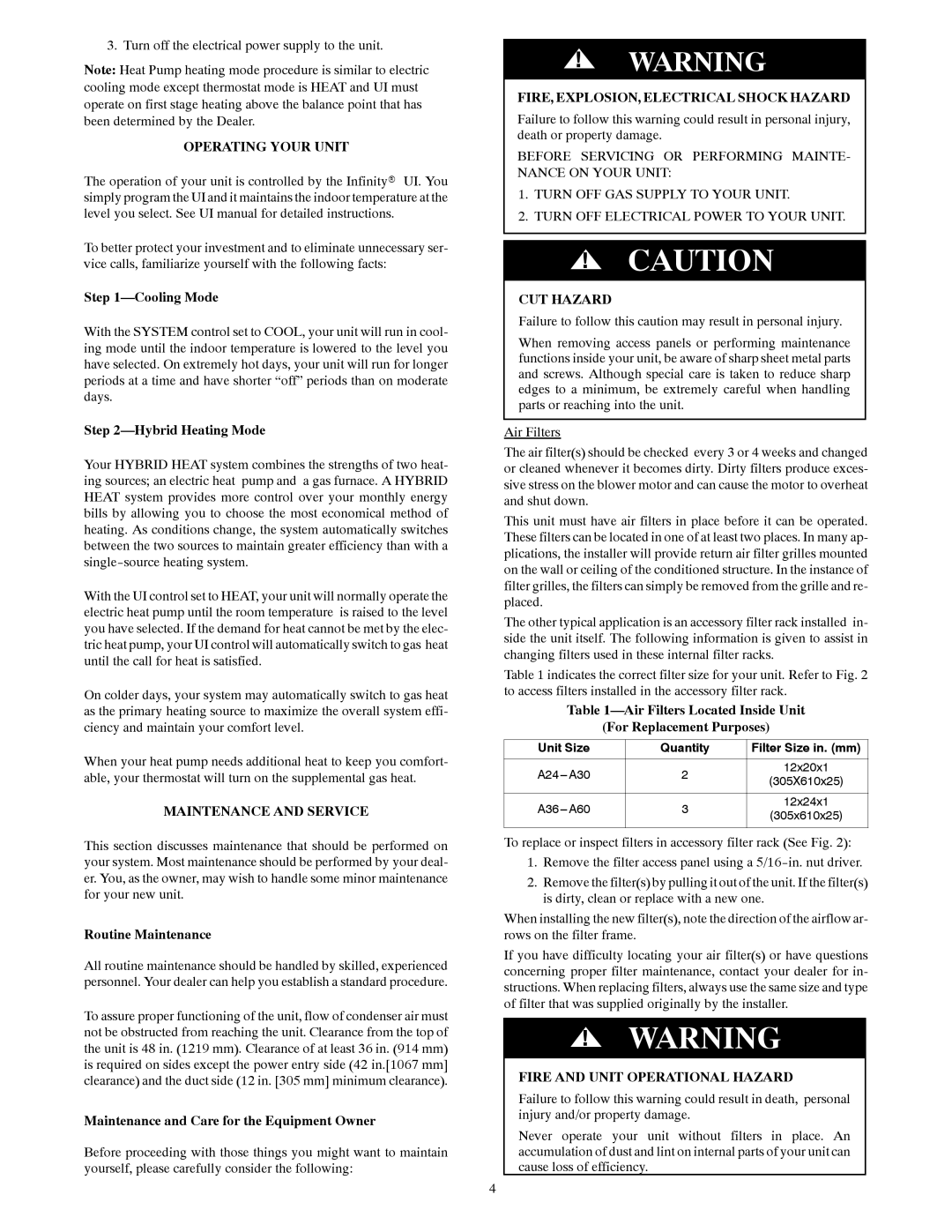3. Turn off the electrical power supply to the unit.
Note: Heat Pump heating mode procedure is similar to electric cooling mode except thermostat mode is HEAT and UI must operate on first stage heating above the balance point that has been determined by the Dealer.
OPERATING YOUR UNIT
The operation of your unit is controlled by the Infinityr UI. You simply program the UI and it maintains the indoor temperature at the level you select. See UI manual for detailed instructions.
To better protect your investment and to eliminate unnecessary ser- vice calls, familiarize yourself with the following facts:
Step 1—Cooling Mode
With the SYSTEM control set to COOL, your unit will run in cool- ing mode until the indoor temperature is lowered to the level you have selected. On extremely hot days, your unit will run for longer periods at a time and have shorter “off” periods than on moderate days.
Step 2—Hybrid Heating Mode
Your HYBRID HEAT system combines the strengths of two heat- ing sources; an electric heat pump and a gas furnace. A HYBRID HEAT system provides more control over your monthly energy bills by allowing you to choose the most economical method of heating. As conditions change, the system automatically switches between the two sources to maintain greater efficiency than with a single-source heating system.
With the UI control set to HEAT, your unit will normally operate the electric heat pump until the room temperature is raised to the level you have selected. If the demand for heat cannot be met by the elec- tric heat pump, your UI control will automatically switch to gas heat until the call for heat is satisfied.
On colder days, your system may automatically switch to gas heat as the primary heating source to maximize the overall system effi- ciency and maintain your comfort level.
When your heat pump needs additional heat to keep you comfort- able, your thermostat will turn on the supplemental gas heat.
MAINTENANCE AND SERVICE
This section discusses maintenance that should be performed on your system. Most maintenance should be performed by your deal- er. You, as the owner, may wish to handle some minor maintenance for your new unit.
Routine Maintenance
All routine maintenance should be handled by skilled, experienced personnel. Your dealer can help you establish a standard procedure.
To assure proper functioning of the unit, flow of condenser air must not be obstructed from reaching the unit. Clearance from the top of the unit is 48 in. (1219 mm). Clearance of at least 36 in. (914 mm) is required on sides except the power entry side (42 in.[1067 mm] clearance) and the duct side (12 in. [305 mm] minimum clearance).
Maintenance and Care for the Equipment Owner
Before proceeding with those things you might want to maintain yourself, please carefully consider the following:
!WARNING
FIRE, EXPLOSION, ELECTRICAL SHOCK HAZARD
Failure to follow this warning could result in personal injury, death or property damage.
BEFORE SERVICING OR PERFORMING MAINTE- NANCE ON YOUR UNIT:
1.TURN OFF GAS SUPPLY TO YOUR UNIT.
2.TURN OFF ELECTRICAL POWER TO YOUR UNIT.
!CAUTION
CUT HAZARD
Failure to follow this caution may result in personal injury.
When removing access panels or performing maintenance functions inside your unit, be aware of sharp sheet metal parts and screws. Although special care is taken to reduce sharp edges to a minimum, be extremely careful when handling parts or reaching into the unit.
Air Filters
The air filter(s) should be checked every 3 or 4 weeks and changed or cleaned whenever it becomes dirty. Dirty filters produce exces- sive stress on the blower motor and can cause the motor to overheat and shut down.
This unit must have air filters in place before it can be operated. These filters can be located in one of at least two places. In many ap- plications, the installer will provide return air filter grilles mounted on the wall or ceiling of the conditioned structure. In the instance of filter grilles, the filters can simply be removed from the grille and re- placed.
The other typical application is an accessory filter rack installed in- side the unit itself. The following information is given to assist in changing filters used in these internal filter racks.
Table 1 indicates the correct filter size for your unit. Refer to Fig. 2 to access filters installed in the accessory filter rack.
Table 1—Air Filters Located Inside Unit
(For Replacement Purposes)
| Unit Size | Quantity | Filter Size in. (mm) |
| | | |
| A24--- A30 | 2 | 12x20x1 |
| (305X610x25) |
| | |
| | | |
| A36--- A60 | 3 | 12x24x1 |
| (305x610x25) |
| | |
| | | |
To replace or inspect filters in accessory filter rack (See Fig. 2):
1.Remove the filter access panel using a 5/16-in. nut driver.
2.Remove the filter(s) by pulling it out of the unit. If the filter(s) is dirty, clean or replace with a new one.
When installing the new filter(s), note the direction of the airflow ar- rows on the filter frame.
If you have difficulty locating your air filter(s) or have questions concerning proper filter maintenance, contact your dealer for in- structions. When replacing filters, always use the same size and type of filter that was supplied originally by the installer.
!WARNING
FIRE AND UNIT OPERATIONAL HAZARD
Failure to follow this warning could result in death, personal injury and/or property damage.
Never operate your unit without filters in place. An accumulation of dust and lint on internal parts ofyour unit can cause loss of efficiency.

